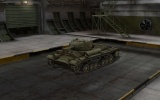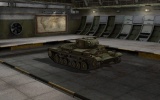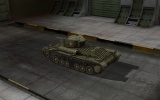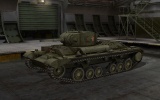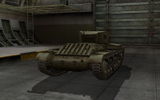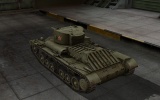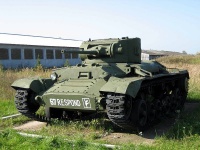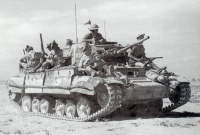Valentine II
| Revision as of 10:51, 31 March 2012 | Revision as of 19:55, 1 May 2012 Bolding, Cap and linking policy compliance edit | |||
| Line 2: | Line 2: | |||
| {{panel title|icon=[[image:USSR-Valentine LL.png|link=|left]]|rMargin=248px|content= | {{panel title|icon=[[image:USSR-Valentine LL.png|link=|left]]|rMargin=248px|content= | |||
| ? | The Valentine is a British tier 4 [[Light Tanks| | + | The '''Valentine''' is a British tier 4 [[Gold Economy|premium]] [[Light Tanks|light tank]] that is lend leased to the [[USSR]]. Currently available for purchase in the store it was also available as a promotion for joining the 2nd phase of closed beta. The Valentine is a strange light tank having the best armor and hit points among light tanks of its tier, but also the poorest maneuvering ability, acceleration, and top speed. It is also armed with a rather underpowered 45mm gun, not quite suitable for fighting tier 4 tanks. In battle it is recommended that you primarily load high explosive rounds as armor piercing shells will generally not penetrate your target's armor, unless firing at the sides or rear. This tank is best played in one of two ways: as a defender, guarding your own base and killing rushing enemy scouts, or as a support tank, de-tracking the enemy and harassing them with your high rate of fire. It can be a difficult tank to play, but the experience gained while developing a working "hit and hide" strategy will prove invaluable as you work your way up to stronger vehicles. | |
| }}{{:{{PAGENAME}}/Modules}}{{:{{PAGENAME}}/Equipment}}{{:{{PAGENAME}}/Consumables}} | }}{{:{{PAGENAME}}/Modules}}{{:{{PAGENAME}}/Equipment}}{{:{{PAGENAME}}/Consumables}} | |||
| {{Panel Gallery|Gallery| | {{Panel Gallery|Gallery| | |||
Revision as of 19:55, 1 May 2012
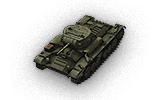
The Valentine is a British tier 4 premium light tank that is lend leased to the USSR. Currently available for purchase in the store it was also available as a promotion for joining the 2nd phase of closed beta. The Valentine is a strange light tank having the best armor and hit points among light tanks of its tier, but also the poorest maneuvering ability, acceleration, and top speed. It is also armed with a rather underpowered 45mm gun, not quite suitable for fighting tier 4 tanks. In battle it is recommended that you primarily load high explosive rounds as armor piercing shells will generally not penetrate your target's armor, unless firing at the sides or rear. This tank is best played in one of two ways: as a defender, guarding your own base and killing rushing enemy scouts, or as a support tank, de-tracking the enemy and harassing them with your high rate of fire. It can be a difficult tank to play, but the experience gained while developing a working "hit and hide" strategy will prove invaluable as you work your way up to stronger vehicles.
R31 Valentine LL/ModulesR31 Valentine LL/EquipmentR31 Valentine LL/Consumables
Historical Info
There are several proposed explanations for the name Valentine. According to the most popular one, the design was presented to the War Office on St. Valentine's Day, 14 February 1940, although some sources say that the design was submitted on 10 February. According to another version, the tank was called Valentine in honor of Sir John Valentine Carden, the man who led the development of the A10 and many other Vickers vehicles, and had died three years before. Another version says that Valentine is an acronym for Vickers-Armstrong Ltd Elswick & (Newcastle-upon) Tyne. The "most prosaic" is that it was just an in-house codeword of Vickers with no other significance.
History
The Valentine was an infantry tank produced in the United Kingdom during the Second World War. Acounting for approximately a quarter of wartime British tank production, more than 8,000 of these tanks were produced in 11 different marks, including various purpose-built variants. Over its lifetime, it went from a riveted construction to entirely welded, and from a petrol powerplant to a two-stroke diesel engine produced by GMC, which was less likely to catch fire. It was supplied to the USSR and built under license in Canada. Developed by Vickers, it proved to be both strong and reliable.
Based on the A10 Cruiser tank, the Valentine was privately designed by Vickers-Armstrongs (hence its lack of a General Staff "A" designation) and was submitted to the War Office on 10 February 1938. The development team tried to match the lower weight of a cruiser tank (allowing the suspension and transmission parts of the A10 heavy cruiser to be used) and coupled this with the greater armor of an infantry tank. The result is a very compact vehicle with a cramped interior and two-man turret. Its armor was weaker than the Infantry Tank II Matilda but, due to a weaker engine, the lighter tank had the same top speed. However, the new design was easier to produce and much less expensive.
The War Office was initially deterred by the size of the turret, since they considered a turret crew of three necessary to free the vehicle commander from direct involvement in operating the gun. Concerned by the situation in Europe, however, it finally approved the design in April 1939. The vehicle reached trials in May 1940, which coincided with the loss of much of Britain's materiel in France during the evacuation at Dunkirk. The trials were successful and the vehicle was rushed into production as the Infantry Tank III Valentine. No pilot models were required, as much of the mechanics had been proven on the A10, and it entered service from July 1940.
The first Valentines used a petrol engine with conventional steering. The Mark II used a diesel version of the engine, and the Mark IV a GMC diesel: these were the majority of those used in the desert campaigns. Improved tracks were added and the No. 19 Wireless replaced the No. 11. The Valentine remained in production until April 1944, becoming Britain's most-produced tank during the war with 6,855 units manufactured in the UK (by Vickers, Metropolitan-Cammell Carriage and Wagon, and Birmingham Railway Carriage and Wagon), and a further 1,420 in Canada.
Combat history
The tank first served in Operation Crusader in the North African desert, where it began to replace the Matilda. It was extensively used in the North African Campaign, earning a reputation as a reliable and well-protected vehicle. The Valentine shared the common weakness' of the British tanks of the period: its 2-pounder gun lacked high-explosive (anti-personnel) capability, and soon became outdated as an anti-tank weapon as well. The small size of the turret and turret ring made mounting larger guns a difficult task. Although versions with the 6-pounder, and then with the Ordnance QF 75 mm gun were developed, by the time they were available in significant numbers, better tanks had reached the battlefield. Another weakness was the small crew compartment and the turret for only two men. A larger turret with a loader position added was used in some of the 2-pounder versions, but the position had to be removed again in variants with larger guns. By 1944, the Valentine had been almost completely replaced in front-line units of the European Theatre by the Infantry Tank IV Churchill and the US-made Sherman. In the Pacific, the tank was employed in limited numbers at least until May 1945. It was used in New Zealand's service, some with the main armament replaced by the 3 inch howitzer taken from Australian Matilda CS tanks.[citation needed], on the Solomons in 1943. In Soviet service, the Valentine was used from the Battle of Moscow until the end of the war. Although criticized for its low speed and weak gun, the Valentine was liked due to its small size, reliability, and generally-good armor protection.
Lend Lease
The Valentine was the Commonwealth's main export to the Soviet Union under the Lend-lease Act, with 2,394 of the British models and 1,388 of the Canadian Pacific-built models being sent: the remaining 30 being kept for training. Typically, Lend-Lease vehicles were worse than modern Soviets ones. However, at the same time, the USSR also used even more obsolete tanks and planes.
| Light Tanks | MS-1 • BT-2 • Tetrarch • T-26 • T-60 • BT-7 • BT-SV • LTP • M3 Light • T-127 • T-46 • T-70 • A-20 • T-50 • T-80 • Valentine II • T-50-2 • MT-25 |
| Medium Tanks | A-32 • T-28 • Matilda IV • T-34 • T-34-85 • A-43 • KV-13 • T-43 • A-44 • T-44 • Object 416 • T-54 • Object 430 II • Object 283 • T-62A • Object 140 • Object 430 |
| Heavy Tanks | Churchill III • KV • KV-1 • KV-220 • KV-220 Beta-Test • KV-1S • KV-2 • T-150 • IS • KV-3 • IS-3 • IS-6 • KV-4 • KV-5 • IS-8 • ST-I • IS-4 • IS-7 |
| Tank Destroyers | AT-1 • SU-76 • SU-85B • SU-85 • SU-85I • SU-100 • SU-100Y • SU-100M1 • SU-122-44 • SU-152 • ISU-152 • SU-101 • Object 704 • SU-122-54 • Object 263 • Object 268 |
| Self-Propelled Guns | SU-18 • SU-26 • SU-5 • SU-122A • SU-8 • S-51 • SU-14-1 • SU-14-2 • 212A • Object 261
|
